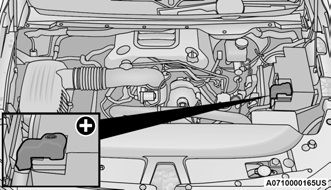Jump starting
If your vehicle has a discharged battery, it can be jump started using a set of jumper cables and a battery in another vehicle, or by using a portable battery booster pack. Jump starting can be dangerous if done improperly, so please follow the procedures in this section carefully.
⚠ WARNING!
Do not attempt jump starting if the battery is frozen. It could rupture or explode and cause personal injury.
CAUTION!
Do not use a portable battery booster pack or any other booster source with a system voltage greater than 12 Volts or damage to the battery, starter motor, alternator or electrical system may occur.
NOTE:
When using a portable battery booster pack, follow the manufacturer's operating instructions and precautions.
PREPARATIONS FOR JUMP START
The battery in your vehicle is located in the front of the engine compartment, behind the left headlight assembly.

Battery Location
NOTE:
The positive battery post may be covered with a protective cap if equipped. Lift up on the cap to gain access to the positive battery post. Do not jump off fuses. Only jump directly off positive post which has a positive (+) symbol on or around the post.
Follow the below steps to prepare for jump starting:
1. Shift the automatic transmission into PARK, apply the parking brake and turn the ignition OFF.
2. Turn off the heater, radio, and all electrical accessories.
3. Pull upward and remove the protective cap from the remote positive (+) battery post.
4. When using another vehicle to jump start the battery, park the vehicle within the jumper cables’ reach, apply the parking brake, shift the automatic transmission into PARK and turn the ignition OFF.
⚠ WARNING!
Do not allow vehicles to touch each other as this could establish a ground connection and personal injury could result.
⚠ WARNING!
● Take care to avoid the radiator cooling fan whenever the hood is raised. It can start anytime the ignition switch is ON. You can be injured by moving fan blades.
● Remove any metal jewelry such as rings, watch bands and bracelets that could make an inadvertent electrical contact. You could be seriously injured.
● Batteries contain sulfuric acid that can burn your skin or eyes and generate hydrogen gas which is flammable and explosive. Keep open flames or sparks away from the battery.
JUMP STARTING PROCEDURE
⚠ WARNING!
Failure to follow this jump starting procedure could result in personal injury or property damage due to battery explosion.
CAUTION!
Failure to follow these procedures could result in damage to the charging system of the booster vehicle or the discharged vehicle.
NOTE:
Do not jump off fuses. Only jump directly off positive post.
Connecting The Jumper Cables
1. Connect the positive (+) end of the jumper cable to the positive (+) post of the discharged vehicle.
2. Connect the opposite end of the positive (+) jumper cable to the positive (+) post of the booster battery.
3. Connect the negative (-) end of the jumper cable to the negative (-) post of the booster battery.
4. Connect the opposite end of the negative (-) jumper cable to a good engine ground. A “ground” is an exposed metallic/unpainted part of the engine, frame or chassis, such as an accessory bracket or large bolt. The ground must be away from the battery and the fuel injection system.

Jump Starting Label
⚠ WARNING!
Do not connect the jumper cable to the negative (-) post of the discharged battery. The resulting electrical spark could cause the battery to explode and could result in personal injury.
5. Start the engine in the vehicle that has the booster battery, let the engine idle a few minutes, and then start the engine in the vehicle with the discharged battery.
CAUTION!
Do not connect jumper cable to any of the fuses on the positive battery terminal. The resulting electrical current will blow the fuse.
6. Once the engine is started, follow the disconnection procedure below.
Disconnecting The Jumper Cables
1. Disconnect the negative (-) end of the jumper cable from the engine ground of the vehicle with the discharged battery.
2. Disconnect the opposite end of the negative (-) jumper cable from the negative (-) post of the booster battery.
3. Disconnect the positive (+) end of the jumper cable from the positive (+) post of the booster battery.
4. Disconnect the opposite end of the positive (+) jumper cable from the positive (+) post of the vehicle with the discharged battery and reinstall the protective cap.
If frequent jump starting is required to start your vehicle you should have the battery and charging system inspected at an authorized dealer.
CAUTION!
Accessories plugged into the vehicle power outlets draw power from the vehicle’s battery, even when not in use (i.e., cellular devices, etc.).
Eventually, if plugged in long enough without engine operation, the vehicle’s battery will discharge sufficiently to degrade battery life and/or prevent the engine from starting.